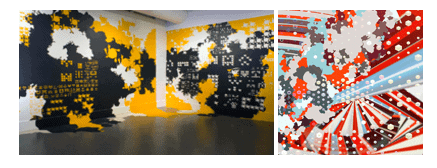
Neil Matthiessen: Perceptual Data
February 7—March 22, 2014
Neil Matthiessen
Neil Matthiessen is a trained printmaker, graphic designer and a self-taught computer programmer. The multimedia range of his studies influence and combine in his work, which draws from science, technology and visual culture.
Matthiessen’s installation breaks down the image-world into a collage of elements and layered colors in order to explore the question of pure form, aesthetic experience and material genesis. The depth at which he investigates the aesthetic realm relates to the way a scientist might study the human body at a cellular level, a graphic designer might use layering technique to achieve an effect, or a computer programmer might design a lively animation by writing an algorithm.
Matthiessen is interested in how computers can be programmed to replicate reality. His process is based on chaos theory and probability theory and he starts each work by writing a set of mathematical operations that produce forms seemingly found in nature. Next, he prints out these forms in room-sized stencils, which he applies to the wall and paints over. The printing, placement and painting of the stencils add an element of human error and chance into the controlled computer-generated work.
Matthiessen’s process is described as Generative art, a genre Brian Eno popularized in the 1990s with his experiments in electronic music, which took roots in Philip Glass and Steve Reich’s experiments in New York City’s 1960s downtown art scene. Like Eno, Matthiessen lets the computer system take over in some of the decision-making, while his human hand, the quality of the paint, the personality of the sand and the ephemeral life form of the gallery itself (temperature, light, atmosphere, warp) symphonize the final effect.
The installation poses questions about the relationship between humans, technology and the rendering of forms in nature. These questions push curiously at the origin of all known matter, dark matter and life itself. Can humans collaborate with machines to realize new aesthetic forms imperceptible to the naked eye or not yet discovered? Can a mathematical equation quantify human aesthetics? How might the tension between computer-human collaboration and codependency realize our postmodern condition?
About the Artist:
Neil Matthiessen received his BFA from The University of Montana, MA from West Virginia University and an MFA from the Minneapolis College of Art and Design. Prior becoming Assistant Professor at USF St Pete Neil has taught at Arkansas State University, Brown College (Mendota Heights, MN) and The Art Institute International (Minneapolis Minnesota). Neil has created environmental, print and web designs for companies such as Medtronic, Toro, Carlson Companies and Coke. He currently serves on the XCD AIGA board. the Center for the Study of Political Graphics in Los Angeles, California.
Neil has exhibited his work nationally and internationally. Most recently Neil is included in a traveling show, “The Posters of Discontent”, which includes designers from around the world including England, Turkey, Iran, Israel and the Netherlands. Neil’s work is also included in collections at SangMyung University, Chonan, Korea, Eastern Michigan University and the Center for the Study of Political Graphics in Los Angeles, California.
Learn more about Neil here.